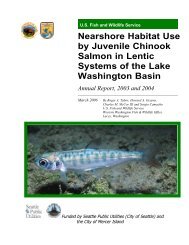2005 State of Mobility Report - City of Bellevue
2005 State of Mobility Report - City of Bellevue
2005 State of Mobility Report - City of Bellevue
Create successful ePaper yourself
Turn your PDF publications into a flip-book with our unique Google optimized e-Paper software.
CHAPTER 9<br />
Transit<br />
9<br />
A convenient and reliable transit system helps to reduce automobile dependency by providing access to,<br />
from, and between major activity centers and local neighborhoods. The <strong>City</strong> works closely with transit<br />
agencies to coordinate improvements to services and facilities that best accommodate transit riders.<br />
The <strong>City</strong> does not provide or manage transit<br />
services and yet transit is a cornerstone <strong>of</strong> our<br />
transportation system. Transit is also an important<br />
element <strong>of</strong> the <strong>City</strong>’s vision for meeting the<br />
growing demand for capacity on city streets.<br />
The <strong>City</strong> Council adopted the 2003 <strong>Bellevue</strong><br />
Transit Plan Update to direct the development<br />
<strong>of</strong> transit facilities and coordinate efforts with<br />
transit providers. The plan <strong>of</strong>fers a comprehensive<br />
review <strong>of</strong> current and future needs for transit and<br />
recommends policy updates, service increases, and<br />
capital facility enhancements.<br />
In <strong>2005</strong>, staff proceeded with implementing<br />
elements <strong>of</strong> the plan. Policy work was advanced<br />
to support regional coordination and planning<br />
for new transit service and technologies serving<br />
<strong>Bellevue</strong>.<br />
Work with the transit providers to implement<br />
the <strong>Bellevue</strong> Transit Plan as an attractive travel<br />
option for local residents, employees, students,<br />
visitors, businesses, and other users <strong>of</strong> regional<br />
facilities.<br />
Comprehensive Plan Policy TR-50<br />
Service Frequency and Ridership<br />
During 2001, the <strong>City</strong> worked with its transit<br />
partners to generate a significant increase in service<br />
hours, including a redeployment <strong>of</strong> 70,000 allocated<br />
but unused service hours. Additional changes<br />
<strong>of</strong> this magnitude are not anticipated until 2007<br />
when King County Metro (Metro) completes the<br />
update <strong>of</strong> its six-year plan. Chart 9-A reflects the<br />
current and target service frequencies, for both the<br />
peak hour and mid-day periods, between <strong>Bellevue</strong>’s<br />
five major activity areas: Downtown, Overlake,<br />
Crossroads, Eastgate, and Factoria.<br />
The <strong>City</strong> evaluates changes in daily transit usage<br />
by comparing average passenger trip volumes<br />
within defined cycles. As Map 9-B indicates, transit<br />
ridership for <strong>2005</strong> continued the upward trend<br />
started in 2002. Between 2004 and <strong>2005</strong>, <strong>Bellevue</strong><br />
average daily ridership (ons and <strong>of</strong>fs) increased 23<br />
percent, from 25,300 to 31,000. The most notable<br />
improvement for this time-period was in the<br />
Downtown (MMA 3) where average daily ridership<br />
increased from 7,660 to 11,351 (48 percent growth).<br />
Significant gains were also witnessed in Crossroads<br />
(26 percent), Factoria (17 percent), and Eastgate (16<br />
percent).<br />
Build It and They Will Ride<br />
Creating a transit service network that supports<br />
existing and emerging travel patterns is a key<br />
strategy for attracting and maintaining transit riders.<br />
However, “the decision to ride” is influenced by<br />
factors in addition to service availability, such as:<br />
• speed and reliability <strong>of</strong> transit service;<br />
• convenience <strong>of</strong> facilities and service access points;<br />
and<br />
• overall attractiveness <strong>of</strong> transit facilities.<br />
<strong>2005</strong> <strong>State</strong> <strong>of</strong> <strong>Mobility</strong> <strong>Report</strong> Chapter 9<br />
71

















